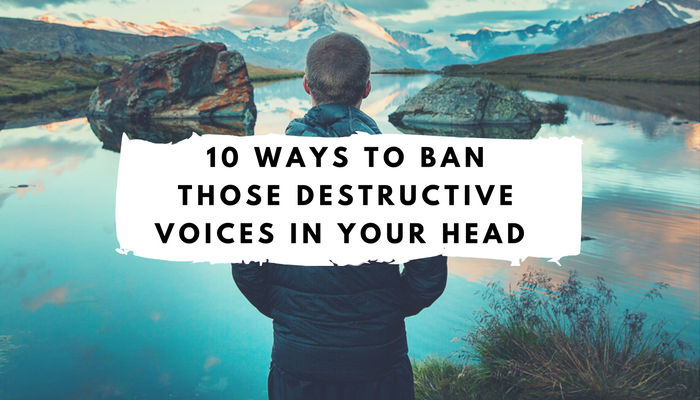VIRTUAL EMDR BLOG
10 Ways to Ban All Those Negative Voices in Your Head
17 Jan 2017
![]() Tag:
Tag:

No, you’re not crazy. Everyone has a running inner dialogue going on in their head.
Often it’s your own voice telling you things, but sometimes it might be the voice of your parents, or your brother, or your drill sergeant, or even your boss.
Sometimes this voice is a good thing, especially when it tells you that you’ve done a great job, that you should be proud, or that you have self-worth.
This is completely normal. We all have listen to it in one way or another. Unfortunately that inner voice doesn't always have nice things to say.
Sometimes that inner dialogue is painful and filled with bitterness or self-loathing or destructive thoughts. It can put you down, tell you that you're a failure, or even that there's no hope for you
Unfortunately, sometimes that inner voice will tell you to give up, or to relieve your pain by using drugs, alcohol, compulsive sex, or overeating to soothe your pain. It seems endless.
And one other thing. Sometimes that inner voice in your head just won’t leave you alone no matter how much you want it to. This is a textbook symptom of trauma and PTSD.
Ever find yourself washing the dishes and having a conversation with your father about something that happened 30 years ago and is still bothering you?
Or maybe catch yourself raging at someone who victimized you even though they aren’t there and have been out of your life for years?
One of the problems with having this kind of inner traumatic voice is that for many people it is accompanied by some pretty ugly behavioral side effects. Your inner voice, also called your inner critic, can push you to get high when you're sober, rage at someone close to you, or even isolate in a state of depression.
Spiritual author Eckhart Tolle says that one of the keys to a happy life is to be present and not identify with all those negative thoughts swirling around in your skull.
“What a liberation to realize that the ‘voice in my head’ is not who I am,” he says. “Who am I then? The one who sees that.”
When your inner voice isn’t supportive and friendly and is instead an ever present toxic mental dialogue, it’s time to action some action for your own well-being.
HERE'S 10 WAYS TO GET RID OF THOSE NEGATIVE VOICES, THOUGHTS, AND EMOTIONS THAT YOU JUST CANT SEEM TO GET OFF YOUR MIND-
1) See a Therapist for Trauma and PTSD- Few things can compare with one-on-one sessions with an expert, and trauma therapists know all about the ugly thoughts in your head and how to best manage them and move on towards a happier life.
Pro Tip- don’t just choose a random therapist online. Instead look for one who specializes in trauma instead. You can even ask for an initial “get to know you’” session for free before you commit to regular sessions.
2) Cognitive Behavioral Therapy (CBT)- Cognitive behavioral therapy is a short-term, hands-on approach to therapy that is a less feelings-oriented and more practical approach to solving problems.
CBT seeks to change people’s behaviors and thinking patterns so they can in-turn change the way they behave. CBT can be used to treat a wide range of problems from addictions, to emotional issues like depression, to trauma and PTSD, and even relationship dysfunctions.
3) EMDR Therapy- EMDR stands for Eye Movement Desensitization and Reprocessing. It’s a type of therapy that uses eye movements, audio tones, or sometimes even little hand-held buzzers to repeatedly stimulate your brain.
EMDR Therapy started back in the late 1980s, and quickly became a go-to treatment approach for healing military veterans who were struggling with combat-related trauma and PTSD. These days, EMDR is being successfully used to treat things like addictions, depression, grief and loss, fears and phobias, and emotional problems as well.
EMDR has exploded in popularity. You can now find thousands of EMDR therapists practicing in nearly every country in the world.
You can also try out EMDR Therapy at-home, but if you do, you need to choose a complete program that teaches you the EMDR process step-by-step. Good examples would be the Virtual EMDR Program or for treating addiction issues, the Virtual EMDR for Addiction Program.
4) Reading Great Books- There’s nothing like a really well thought out self-help book to help you, at least for a while, focus on the good things in life and ban those gloom-and-doom thoughts.
Myrko Thum has a great article that lists out some of the very best. http://www.myrkothum.com/self-help-books/
5) Join a Therapy Group- In addition to offering one-to-one therapy sessions, most successful mental health practices offer regular group therapy sessions where you can openly (and safely mind you) talk about your feelings with others who are experiencing the same or similar problems.
A good therapy group also helps you to build a network of people that you can regularly contact to talk about how you’re feeling.
6) Join a 12 Step Meeting like CoDA or Emotions Anonymous- Codependents Anonymous may not seem like an appropriate place for you to go to, but the truth is the CoDA program is all about our feelings, insecurities, shame, relationships, and how we choose to deal with life and interact with the people closest to us. It’s a program that lets you shine a light into your past and see how the way you grew up is directly tied to the adult you are now.
Both CoDA (and Emotions Anonymous) have hundreds of meetings in countries all over the world. Another bonus of getting into a 12 step program is that you will suddenly be surrounded with a group of like-minded people you can share your thoughts, feelings, and problems with.
I once worked with an amazing therapist named Andrea who told me, “I wished all my clients went to CoDA even if it was just to get a chance to openly talk about their feelings with other people.”
7) Contact or Confront the Person from your past- This may require a lot of courage, and to be honest, it’s not something you should always do. In fact, you may want to seek the advice of a therapy professional first.
It takes a lot of guts to face the person who abused you or hurt you. If you can’t bring yourself to do it in person or over the phone, you can always write a letter. You don’t even need to send the letter, often the simple act of writing is enough to help you start to heal and feel better.
8) Be More Productive- So this approach has nothing to do with psychology or making any sort of permanent change, instead it frankly just gets you distracted from whatever you’re struggling with. It’s old-school advice, but good nonetheless.
I remember years ago when I was in college, my girlfriend at the time left me and I was broken to pieces. My wonderful grandmother May (she passed Nov. 11, 2011 at age 96) gave me a brilliant piece of advice, Get Busy!
Sweep the floor, wash your car, do your homework, move yourself forward! Whatever it takes!
9) Meditation and Mindfulness- Practiced in the East for thousands of years, meditation and mindfulness can help you find some peace with the issues that are troubling you by helping you accept the fact that they are a part of your life’s reality.
If you want to learn a few specific, do it yourself, EMDR-inspired mindfulness techniques, check out this article on my EMDR blog.
10) Brainspotting- Brainspotting is a treatment method similar to EMDR that works by identifying, processing and releasing emotional pains, body pain, trauma and PTSD, and dissociation type symptoms.
Brainspotting uses sound and visual cues and is completed in one-to-one sessions in a therapist’s office.
Brainspotting and EMDR therapist Cynthia Swartzberg explains it in more detail on her blog.
Bonus 1) Biofeedback/Electroshock- I am absolutely amazed as I write this but old-school therapy approaches like biofeedback therapy and electroshock therapy are having a popular resurgence.
I am not personally endorsing anything, but yes there are some who think that shocking yourself repeatedly with electric jolts will help you make big changes. Tell you what. If anyone out there tries it out, please contact me. I’d honestly love to hear about your experience.
Bonus 2) Forgive Yourself- I listed this one last as it perhaps the most important.
An inner traumatic voice is sometimes the result of the very worst things happening in your past.
It may have been child abuse. You may have been a victim of a violent assault or a crime. You may have even had a spouse, partner or loved one pass on.
Just know that it’s not your fault and life goes on. It’s OK to forgive yourself 100%!
Sometimes that inner dialogue is painful and filled with bitterness or self-loathing or destructive thoughts. It can put you down, tell you that you're a failure, or even that there's no hope for you
The question is, What Can You Do About It? How can you take back control and shut down that ugly, negative inner dialogue. Let us show you how.
Unfortunately, sometimes that inner voice will tell you to give up, or to relieve your pain by using drugs, alcohol, compulsive sex, or overeating to soothe your pain. It seems endless.
And one other thing. Sometimes that inner voice in your head just won’t leave you alone no matter how much you want it to. This is a textbook symptom of trauma and PTSD.
Ever find yourself washing the dishes and having a conversation with your father about something that happened 30 years ago and is still bothering you?
Or maybe catch yourself raging at someone who victimized you even though they aren’t there and have been out of your life for years?
One of the problems with having this kind of inner traumatic voice is that for many people it is accompanied by some pretty ugly behavioral side effects. Your inner voice, also called your inner critic, can push you to get high when you're sober, rage at someone close to you, or even isolate in a state of depression.
Spiritual author Eckhart Tolle says that one of the keys to a happy life is to be present and not identify with all those negative thoughts swirling around in your skull.
“What a liberation to realize that the ‘voice in my head’ is not who I am,” he says. “Who am I then? The one who sees that.”
When your inner voice isn’t supportive and friendly and is instead an ever present toxic mental dialogue, it’s time to action some action for your own well-being.
HERE'S 10 WAYS TO GET RID OF THOSE NEGATIVE VOICES, THOUGHTS, AND EMOTIONS THAT YOU JUST CANT SEEM TO GET OFF YOUR MIND-
1) See a Therapist for Trauma and PTSD- Few things can compare with one-on-one sessions with an expert, and trauma therapists know all about the ugly thoughts in your head and how to best manage them and move on towards a happier life.
Pro Tip- don’t just choose a random therapist online. Instead look for one who specializes in trauma instead. You can even ask for an initial “get to know you’” session for free before you commit to regular sessions.
2) Cognitive Behavioral Therapy (CBT)- Cognitive behavioral therapy is a short-term, hands-on approach to therapy that is a less feelings-oriented and more practical approach to solving problems.
CBT seeks to change people’s behaviors and thinking patterns so they can in-turn change the way they behave. CBT can be used to treat a wide range of problems from addictions, to emotional issues like depression, to trauma and PTSD, and even relationship dysfunctions.
3) EMDR Therapy- EMDR stands for Eye Movement Desensitization and Reprocessing. It’s a type of therapy that uses eye movements, audio tones, or sometimes even little hand-held buzzers to repeatedly stimulate your brain.
EMDR Therapy started back in the late 1980s, and quickly became a go-to treatment approach for healing military veterans who were struggling with combat-related trauma and PTSD. These days, EMDR is being successfully used to treat things like addictions, depression, grief and loss, fears and phobias, and emotional problems as well.
EMDR has exploded in popularity. You can now find thousands of EMDR therapists practicing in nearly every country in the world.
You can also try out EMDR Therapy at-home, but if you do, you need to choose a complete program that teaches you the EMDR process step-by-step. Good examples would be the Virtual EMDR Program or for treating addiction issues, the Virtual EMDR for Addiction Program.
4) Reading Great Books- There’s nothing like a really well thought out self-help book to help you, at least for a while, focus on the good things in life and ban those gloom-and-doom thoughts.
Myrko Thum has a great article that lists out some of the very best. http://www.myrkothum.com/self-help-books/
5) Join a Therapy Group- In addition to offering one-to-one therapy sessions, most successful mental health practices offer regular group therapy sessions where you can openly (and safely mind you) talk about your feelings with others who are experiencing the same or similar problems.
A good therapy group also helps you to build a network of people that you can regularly contact to talk about how you’re feeling.
6) Join a 12 Step Meeting like CoDA or Emotions Anonymous- Codependents Anonymous may not seem like an appropriate place for you to go to, but the truth is the CoDA program is all about our feelings, insecurities, shame, relationships, and how we choose to deal with life and interact with the people closest to us. It’s a program that lets you shine a light into your past and see how the way you grew up is directly tied to the adult you are now.
Both CoDA (and Emotions Anonymous) have hundreds of meetings in countries all over the world. Another bonus of getting into a 12 step program is that you will suddenly be surrounded with a group of like-minded people you can share your thoughts, feelings, and problems with.
I once worked with an amazing therapist named Andrea who told me, “I wished all my clients went to CoDA even if it was just to get a chance to openly talk about their feelings with other people.”
7) Contact or Confront the Person from your past- This may require a lot of courage, and to be honest, it’s not something you should always do. In fact, you may want to seek the advice of a therapy professional first.
It takes a lot of guts to face the person who abused you or hurt you. If you can’t bring yourself to do it in person or over the phone, you can always write a letter. You don’t even need to send the letter, often the simple act of writing is enough to help you start to heal and feel better.
8) Be More Productive- So this approach has nothing to do with psychology or making any sort of permanent change, instead it frankly just gets you distracted from whatever you’re struggling with. It’s old-school advice, but good nonetheless.
I remember years ago when I was in college, my girlfriend at the time left me and I was broken to pieces. My wonderful grandmother May (she passed Nov. 11, 2011 at age 96) gave me a brilliant piece of advice, Get Busy!
Sweep the floor, wash your car, do your homework, move yourself forward! Whatever it takes!
9) Meditation and Mindfulness- Practiced in the East for thousands of years, meditation and mindfulness can help you find some peace with the issues that are troubling you by helping you accept the fact that they are a part of your life’s reality.
If you want to learn a few specific, do it yourself, EMDR-inspired mindfulness techniques, check out this article on my EMDR blog.
10) Brainspotting- Brainspotting is a treatment method similar to EMDR that works by identifying, processing and releasing emotional pains, body pain, trauma and PTSD, and dissociation type symptoms.
Brainspotting uses sound and visual cues and is completed in one-to-one sessions in a therapist’s office.
Brainspotting and EMDR therapist Cynthia Swartzberg explains it in more detail on her blog.
Bonus 1) Biofeedback/Electroshock- I am absolutely amazed as I write this but old-school therapy approaches like biofeedback therapy and electroshock therapy are having a popular resurgence.
I am not personally endorsing anything, but yes there are some who think that shocking yourself repeatedly with electric jolts will help you make big changes. Tell you what. If anyone out there tries it out, please contact me. I’d honestly love to hear about your experience.
Bonus 2) Forgive Yourself- I listed this one last as it perhaps the most important.
An inner traumatic voice is sometimes the result of the very worst things happening in your past.
It may have been child abuse. You may have been a victim of a violent assault or a crime. You may have even had a spouse, partner or loved one pass on.
Just know that it’s not your fault and life goes on. It’s OK to forgive yourself 100%!










I'm grateful for the wealth of resources in this article. Ive found 12 Step programs to be incredibly helpful & agree that, if nothing else, it can help simply for the company of people who know exactly how you feel. I appreciate that sense of belonging even more lately as I've distanced myself from unhealthy relationships and begun facing the loneliness I've avoided most of my adult life. I started in Al-Anon during a sibling's active alcoholism then found "my home" in ACoA - Adult Children of Alcoholics (and Other Dysfunction. It's invaluable for those looking to understand, process & heal the trauma & other life-altering effects of being raised in any type of dysfunctional environment. Learning how & why my self-defeating habits formed was a game-changer. I've also tried CodA but never heard of Emotions Anonymous but it sounds interesting & worth looking up. To anyone thinking of going for the first time I say definitely give it a try & don't let any one aspect of it scare you away. My sibling had always avoided AA because of the "god" aspect but he tried it & came to accept that a "higher power" isn't forced on you. It helped him start a productive path to now 5 years of sobriety even though he no longer attends regularly if at all. Also it's not a substitute for therapy but very helpful for those who can't afford therapy. I advise treating a new meeting the same way the article advised finding a therapist - each is a little different so keep trying until you find one you feel comfortable with. There's nothing required of you most you should be asked to do is share your first name & if its your first meeting. I hope this may be helpful to someone thinking of going to any 12 step meeting. Good luck to us all in our journeys!